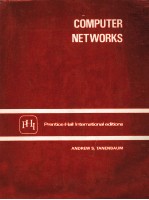图书介绍
Computer networksPDF|Epub|txt|kindle电子书版本下载

- Andrew S.Tanenbaum 著
- 出版社: lnc.Englewood cliffs
- ISBN:
- 出版时间:1981
- 标注页数:517页
- 文件大小:22MB
- 文件页数:533页
- 主题词:
PDF下载
下载说明
Computer networksPDF格式电子书版下载
下载的文件为RAR压缩包。需要使用解压软件进行解压得到PDF格式图书。建议使用BT下载工具Free Download Manager进行下载,简称FDM(免费,没有广告,支持多平台)。本站资源全部打包为BT种子。所以需要使用专业的BT下载软件进行下载。如BitComet qBittorrent uTorrent等BT下载工具。迅雷目前由于本站不是热门资源。不推荐使用!后期资源热门了。安装了迅雷也可以迅雷进行下载!
(文件页数 要大于 标注页数,上中下等多册电子书除外)
注意:本站所有压缩包均有解压码: 点击下载压缩包解压工具
图书目录
1 INTRODUCTION1
1.1 THE USES OF COMPUTER NETWORKS3
1.1.1.Network Goals3
1.1.2.Applications of Networks5
1.2 NETWORK STRUCTURE7
1.3 NETWORK ARCHITECTURES10
1.3.1.Protocol Hierarchies10
1.3.2.Design Issues for the Layers14
1.4 THE ISO REFERENCE MODEL15
1.4.1.The Physical Layer16
1.4.2.The Data Link Layer17
1.4.3.The Network Layer17
1.4.4.The Transport Layer18
1.4.5.The Session Layer19
1.4.6.The Presentation Layer20
1.4.7.The Application Layer21
1.5 ARPANET,SNA,DECNET,AND PUBLIC NETWORKS21
1.5.1.Introduction to the ARPANET22
1.5.2.Introduction to SNA23
1.5.3.Introduction to DECNET26
1.5.4.Introduction to Public Networks and X.2528
1.6 OUTLINE OF THE REST OF THE BOOK29
1.7 SUMMARY30
2 NETWORK TOPOLOGY32
2.1 INTRODUCTION TO THE TOPOLOGY DESIGN PROBLEM32
2.1.1.Formulation of the Problem32
2.1.2.Hierarchical Networks34
2.2 CONNECTIVITY ANALYSIS36
2.2.1.Introduction to Graph Theory36
2.2.2.Cuts and Network Flow40
2.2.3.The Max-Flow Algorithm44
2.2.4.Disjoint Paths47
2.2.5.Monte Carlo Connectivity Analysis54
2.3 DELAY ANALYSIS56
2.3.1.Introduction to Queueing Theory57
2.3.2.The M/M/1 Queue in Equilibrium59
2.3.3.Networks of M/M/1 Queues62
2.4 BACKBONE DESIGN67
2.4.1.The Design Process67
2.4.2.Generating Starting Topologies70
2.4.3.Flow and Capacity Assignment72
2.4.4.Perturbation Heuristics75
2.5 LOCAL ACCESS NETWORK DESIGN80
2.5.1.Assigning Sites to Concentrators80
2.5.2.The Concentrator Location Problem83
2.5.3.The Terminal Layout Problem84
2.6 SUMMARY87
3 THE PHYSICAL LAYER91
3.1 THE THEORETICAL BASIS FOR DATA COMMUNICATION91
3.1.1.Fourier Analysis91
3.1.2.Bandwidth Limited Signals92
3.1.3.The Maximum Data Rate of a Channel95
3.2 THE TELEPHONE SYSTEM96
3.2.1.Who’s Who in the Telecommunication World97
3.2.2.Structure of the Telephone System98
3.2.3.The Local Loop100
3.3 TRANSMISSION AND MULTIPLEXING103
3.3.1.Frequency Division and Time Division Multiplexing103
3.3.2.Digital Transmission104
3.3.3.The X.21 Digital Interface108
3.3.4.Communication Satellites110
3.3.5.Circuit Switching and Packet Switching114
3.4 TERMINAL HANDLING119
3.4.1.Polling119
3.4.2.Multiplexing versus Concentration121
3.4.3.The Packet Assembler/ Disassembler122
3.5 ERRORS125
3.5.1.The Nature of Transmission Errors125
3.5.2.Error-Correcting Codes126
3.5.3.Error-Detecting Codes128
3.6 SUMMARY133
4 THE DATA LINK LAYER136
4.1 ELEMENTARY DATA LINK PROTOCOLS136
4.1.1.Some Declarations Needed by the Protocols137
4.1.2.An Unrestricted Simplex Protocol141
4.1.3.A Simplex Stop-and-Wait Protocol143
4.1.4.A Simplex Protocol for a Noisy Channel145
4.2 SLIDING WINDOW PROTOCOLS148
4.2.1.A One Bit Sliding Window Protocol151
4.2.2.A Protocol with Pipelining153
4.2.3.A Protocol That Accepts Frames Out of Order157
4.3 EXAMPLES OF THE DATA LINK LAYER165
4.3.1.The Data Link Layer in the ARPANET165
4.3.2.The Data Link Layer in SNA and X.25167
4.3.3.The Data Link Layer in DECNET172
4.4 ANALYSIS OF PROTOCOLS174
4.4.1.Protocol Efficiency174
4.4.2.Protocol Verification177
4.5 SUMMARY183
5 THE NETWORK LAYER I:POINT-TO-POINT NETWORKS187
5.1 VIRTUAL CIRCUITS AND DATAGRAMS187
5.1.1.The Service Provided by the Network Layer188
5.1.2.Comparison of Virtual Circuit and Datagram Service189
5.1.3.The Internal Structure of the Subnet192
5.1.4.Comparison of VCs and Datagrams within the Subnet195
5.1.5.Independence of Subnet Service and Subnet Structure196
5.2 ROUTING ALGORITHMS197
5.2.1.Flooding198
5.2.2.Static Routing199
5.2.3.Centralized Routing Algorithms200
5.2.4.Isolated Routing202
5.2.5.Distributed Routing Algorithms205
5.2.6.The Topology Update Problem207
5.2.7.Hierarchical Routing211
5.2.8.Broadcast Routing213
5.3 CONGESTION215
5.3.1.Preallocation of Buffers216
5.3.2.Packet Discarding217
5.3.3.Isarithmic Congestion Control219
5.3.4.Flow Control220
5.3.5.Choke Packets221
5.3.6.Deadlocks222
5.4 EXAMPLES OF THE NETWORK LAYER225
5.4.1.The Network Layer in the ARPANET226
5.4.2.The Network Layer in SNA231
5.4.3.The Network Layer in DECNET235
5.4.4.The Network Layer in X.25237
5.5 SUMMARY245
6 THE NETWORK LAYER Ⅱ:SATELLITE AND PACKET RADIO NETWORKS249
6.1 SATELLITE PACKET BROADCASTING250
6.1.1.Conventional Channel Allocation Methods251
6.1.2.Pure ALOHA and Slotted ALOHA253
6.1.3.Finite Population ALOHA257
6.1.4.Delay and Throughput of Slotted ALOHA259
6.1.5.Stability of Slotted ALOHA265
6.1.6.Controlled ALOHA269
6.1.7.Reservation ALOHA271
6.2 PACKET RADIO273
6.2.1.The University of Hawaii ALOHA System273
6.2.2.Design Issues for Packet Radio Networks277
6.3 SUMMARY282
7 THE NETWORK LAYER Ⅲ:LOCAL NETWORKS286
7.1 CARRIER SENSE NETWORKS288
7.1.1.Persistent and Nonpersistent CSMA289
7.1.2.Ethernet292
7.1.3.Collision-Free Protocols296
7.1.4.Limited-Contention Protocols300
7.2 RING NETWORKS307
7.2.1.Token Rings307
7.2.2.Contention Rings311
7.2.3.Slotted Rings312
7.2.4.Register Insertion Rings313
7.3 SHARED MEMORY SYSTEMS315
7.3.1.Processor-Memory Interconnection315
7.3.2.Examples of Shared Memory Systems317
7.4 SUMMARY320
8 THE TRANSPORT AND SESSION LAYERS324
8.1 TRANSPORT PROTOCOL DESIGN ISSUES325
8.1.1.Transport Service326
8.1.2.Addressing and Connection Establishment335
8.1.3.Flow Control and Buffering338
8.1.4.Multiplexing343
8.1.5.Synchronization in the Presence of Delayed Packets345
8.1.6.Crash Recovery351
8.2 INTERCONNECTION OF PACKET-SWITCHING NETWORKS353
8.2.1.Gateways354
8.2.2.The Level of Interconnection358
8.2.3.The X.75 Model versus the Datagram Model359
8.2.4.Internetwork Packet Fragmentation364
8.3 THE SESSION LAYER368
8.4 EXAMPLES OF THE TRANSPORT AND SESSION LAYERS369
8.4.1.The Transport Layer in the ARPANET369
8.4.2.The Transport and Session Layers in SNA377
8.4.3.The Transport Layer in DECNET380
8.5 SUMMARY381
9 THE PRESENTATION LAYER386
9.1 NETWORK SECURITY AND PRIVACY386
9.1.1.Traditional Cryptography388
9.1.2.The Data Encryption Standard396
9.1.3.The Key Distribution Problem406
9.1.4.Public Key Cryptography410
9.1.5.Authentication and Digital Signatures413
9.2 TEXT COMPRESSION417
9.2.1.Encoding a Finite Set of Equally Likely Symbols418
9.2.2.Huffman Coding419
9.2.3.Context Dependent Encoding420
9.3 VIRTUAL TERMINAL PROTOCOLS421
9.3.1.Classes of Terminals421
9.3.2.The Data Structure Model423
9.3.3.Design Principles425
9.3.4.An Example Virtual Terminal Protocol426
9.4 FILE TRANSFER PROTOCOLS429
9.5 EXAMPLES OF THE PRESENTATION LAYER431
9.5.1.The Presentation Layer in the ARPANET431
9.5.2.The Presentation Layer in SNA433
9.5.3.The Presentation Layer in DECNET434
9.6 SUMMARY435
10 THE APPLICATION LAYER440
10.1 DISTRIBUTED DATA BASE SYSTEMS440
10.1.1.The Relational Data Base Model441
10.1.2.The Relation Distribution Problem446
10.1.3.Query Processing448
10.1.4.Concurrency Control452
10.1.5.Crash Recovery457
10.2 DISTRIBUTED COMPUTATION460
10.2.1.The Hierarchical Model461
10.2.2.The CPU Cache Model462
10.2.3.The User-Server Model464
10.2.4.The Pool Processor Model466
10.2.5.The Data Flow Model468
10.3 NETWORK AND DISTRIBUTED OPERATING SYSTEMS476
10.3.1.Network Operating Systems476
10.3.2.Distributed Operating Systems479
10.3 SUMMARY482
11 READING LIST AND BIBLIOGRAPHY486
11.1 SUGGESTIONS FOR FURTHER READING486
11.1.1 Introduction487
11.1.2 Network Topology487
11.1.3 The Physical Layer488
11.1.4 The Data Link Layer488
11.1.5 The Network Layer Ⅰ:Point-to-Point Networks489
11.1.6 The Network Layer Ⅱ:Satellite and Packet Radio Networks489
11.1.7 The Network Layer Ⅲ:Local Networks490
11.1.8 The Transport and Session Layers490
11.1.9 The Presentation Layer491
11.1.10 The Application Layer492
11.2 ALPHABETICAL BIBLIOGRAPHY493
INDEX508